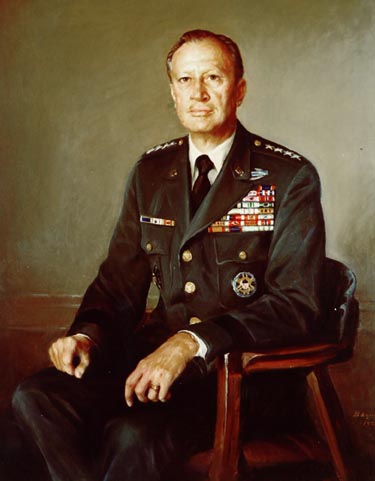
Frederick Carlton Weyand was born in Arbuckle, California, on 15 September 1916; was commissioned a second lieutenant through the Reserve Officers Training Corps program at the University of California at Berkeley, 1938, where he graduated in 1939; married Arline Langhart, 1940; was called to active duty and served with the 6th Artillery, 19401942; was promoted to temporary first lieutenant, June 1941, and to captain in February and major in November 1942; graduated from the Command and General Staff College at Fort Leavenworth, 1942; was adjutant of the Harbor Defense Command, San Francisco, 19421943; served in the Office of the Chief of Intelligence, War Department General Staff, 1944; was assistant chief of staff for intelligence, China-Burma-India Theater, 19441945; was in the Military Intelligence Service, Washington, 19451946; was promoted to temporary lieutenant colonel, March 1945, and permanent captain, July 1948; was chief of staff for intelligence, United States Army Forces, Middle Pacific, 19461949; graduated from the Infantry School at Fort Benning, 1950; was battalion commander in the 7th Infantry and assistant chief of staff, G3, of the 3d Infantry Division in the Korean War, 19501951; served on the faculty of the Infantry School, 19521953; attended the Armed Forces Staff College, 1953; was military assistant in the Office of the Assistant Secretary of the Army for Financial Management, 19531954; was military assistant and executive to the secretary of the Army, 19541957; was promoted to permanent major, July 1953, and temporary colonel, July 1955; graduated from the Army War College, 1958; commanded the 3d Battle Group, 6th Infantry, in Europe, 19581959; served in the Office of the United States Commander in Berlin, 1960; was promoted to temporary brigadier general, July 1960; was chief of staff, Communications Zone, United States Army, Europe, 19601961; was deputy chief and chief of legislative liaison, Department of the Army, 19611964; was promoted to permanent lieutenant colonel, September 1961, and to temporary major general, November 1962; was commander of the 25th Infantry Division, Hawaii, 19641966, and in Vietnam operations, 19661967; was promoted to permanent colonel, September 1966; was deputy, acting commander, and commander of II Field Force, Vietnam, 19671968; was chief of the Office of Reserve Components, 19681969; was promoted to permanent brigadier and major general and temporary lieutenant general, August 1968, and temporary general, October 1970; was military adviser at the Paris peace talks, 19691970; was assistant chief of staff for force development, 1970; was successively deputy commander and commander of the United States Military Assistance Command, Vietnam, 19701973; was commander in chief of the United States Army, Pacific, 1973; was vice chief of staff of the United States Army, 19731974; was chief of staff of the United States Army, 3 October 197431 September 1976; supervised Army moves to improve the combat-to-support troop ratio, to achieve a sixteen-division force, to enhance the effectiveness of roundout units, and to improve personnel and logistical readiness; retired from active service, October 1976.
The Artist
Bjorn Peter Egeli (19001984), who also painted Generals Maxwell D. Taylor and Lyman L. Lemnitzer, drew upon his native Norwegian connections to execute the likenesses of Crown Princess Martha, wife of future King Olav V of Norway, and of the nations longtime ambassador to the United States, Wilhelm Munthe de Morgenstierne. Mr. Egelis children have become accomplished artists in their own right. His son, Cedric, is a contributor to the Army chiefs of staff collection. Mr. Egeli won several awards for his portraiture.
Frederick Carlton Weyand
By Bjorn Peter Egeli
Oil on canvas, 45" x 36", 1975
[146]

[147]